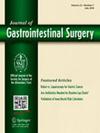肝细胞癌手术时间与肿瘤负荷评分的相互作用分析。
IF 2.4
3区 医学
Q3 GASTROENTEROLOGY & HEPATOLOGY
引用次数: 0
摘要
背景:“手术时间(TTS)”对肝细胞癌(HCC)治疗目的肝切除术结果的影响存在争议。肿瘤负荷评分(Tumor Burden Score, TBS)与TTS之间的相互作用尚不清楚。本研究评估TBS和TTS如何影响HCC的长期预后。方法:从多机构数据库中分析2000-2022年接受治愈性肝切除术的HCC患者,并按TTS(≤或≤60天)进行分类。评估总生存期(OS)和癌症特异性生存期。结果:910例患者中,短TTS组(n=485)中位TTS为22天,长TTS组(n=425)中位TTS为120天。长期TTS组年龄较大,ASA >2级、糖尿病和肝硬化的发生率较高。中位TBS组间差异无统计学意义(4.61vs5.00)。5年OS差异无统计学意义(70.0%vs63.1%, P=0.05)。多变量分析确定TBS (HR:1.07[1.03-1.11])。结论:术前优化是必要的,减少TTS可能改善低TBS队列的预后。本文章由计算机程序翻译,如有差异,请以英文原文为准。
Analyzing the interaction between time to surgery and tumor burden score in hepatocellular carcinoma
Background
The effect of “time to surgery (TTS)” on outcomes for curative-intent hepatectomy of hepatocellular carcinoma (HCC) remains debated. The interaction between tumor burden score (TBS) and TTS remains unclear. We sought to evaluate the effects of TBS and TTS on long-term HCC outcomes.
Methods
Patients with HCC who underwent curative-intent hepatectomy (2000–2022) were analyzed from a multi-institutional database and categorized by TTS (≤60 or >60 days). Overall survival (OS) and cancer-specific survival were assessed.
Results
Among 910 patients, median TTS estimates were 22 days in the short TTS group (n = 485) and 120 days in the long TTS group (n = 425). Patients with long TTS were older and were more likely to have American Society of Anesthesiologists class >2, diabetes mellitus, and cirrhosis. There was no difference in median TBS among patients who had short versus long TTS (4.61 vs 5.00, respectively). In addition, there was no difference in 5-year OS (70.0% vs 63.1%, respectively; P =.05). On multivariate analysis TBS (hazard ratio [HR], 1.07; 95% CI, 1.03–1.11; P <.001), log alpha-fetoprotein (HR, 1.08; 95% CI, 1.01–1.14; P =.02), and albumin-bilirubin score (HR, 2.52; 95% CI, 1.66–3.82; P <.001) were associated with OS. In contrast, TTS was not associated with OS (HR, 1.18; 95% CI, 0.78–1.77; P =.43). Interaction analysis demonstrated that TBS was asssociated with OS among patients with short TTS (HR, 1.12; 95% CI, 1.07–1.17; P <.001), but not among patients with long TTS (HR, 0.98; 95% CI, 0.91–1.05; P =.56). Among patients with low TBS (≤5), higher mortality was observed with long TTS versus short TTS (5-year OS: 82.4% vs 63.0%, respectively; P =.001); however, TTS was not associated with OS among patients with high TBS (5-year OS: 57.9% vs 63.3%, respectively; P =.92). Multivariate analysis demonstrated that long TTS was a risk factor for OS among patients with low TBS (HR, 3.12; 95% CI, 1.60–6.01; P <.001), but not among individuals with high TBS (HR, 0.57; 95% CI, 0.30–1.07; P =.08). Similar trends were observed relative to cancer-specific survival.
Conclusion
TTS needs to be considered in light of patient and tumor-specific factors. Expediting TTS may be particularly important among patients with HCC and a low TBS.
求助全文
通过发布文献求助,成功后即可免费获取论文全文。
去求助
来源期刊
CiteScore
5.50
自引率
3.10%
发文量
319
审稿时长
2 months
期刊介绍:
The Journal of Gastrointestinal Surgery is a scholarly, peer-reviewed journal that updates the surgeon on the latest developments in gastrointestinal surgery. The journal includes original articles on surgery of the digestive tract; gastrointestinal images; "How I Do It" articles, subject reviews, book reports, editorial columns, the SSAT Presidential Address, articles by a guest orator, symposia, letters, results of conferences and more. This is the official publication of the Society for Surgery of the Alimentary Tract. The journal functions as an outstanding forum for continuing education in surgery and diseases of the gastrointestinal tract.

 求助内容:
求助内容: 应助结果提醒方式:
应助结果提醒方式:


